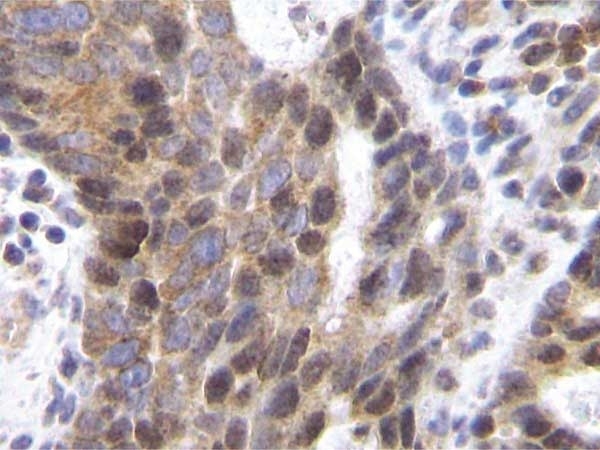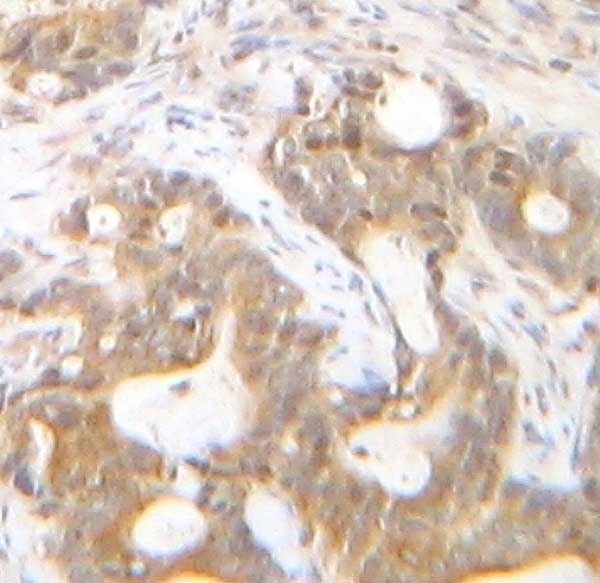SDF-1 Alpha antibody


Rabbit anti Human SDF-1 Alpha:Biotin
- Product Type
- Polyclonal Antibody
- Isotype
- Polyclonal IgG
- Specificity
- SDF-1 Alpha
| Rabbit anti Human SDF-1 alpha antibody recognizes human SDF-1 alpha, otherwise known as CXCL12a, a 68 amino acid stromal cell derived CXC chemokine, which arises from alternative splicing of the SDF-1 gene. The two isoforms, SDF-1 alpha and SDF-1 beta, share an identical amino acid sequence, except for an additional four residues in the C-Terminal region of the beta isoform. SDF-1 binds with high-affinity to the G protein–coupled receptor CXCR4 (fusin) and acts as a chemoattractant for T and B lymphocytes, monocytes and migratory neurons, and is a vital factor in haematopoiesis and angiogenesis. By competitively binding to CXCR4, SDF-1 acts as an inhibitor for the CXCR4-mediated entry of HIV-1 virus into target T-cells, and the SDF-1-CXCR4 interaction is important for the regulation of trafficking of normal and malignant stem cells. |
- Target Species
- Human
- Product Form
- Purified IgG conjugated to Biotin - lyophilized
- Reconstitution
- Reconstitute with 0.5ml sterile PBS containing 0.1% Bovine Serum Albumin.
Care should be taken during reconstitution as the protein may appear as a film at the bottom of the vial. Bio-Rad recommend that the vial is gently mixed after reconstitution. For long term storage the addition of 0.09% sodium azide is recommended. - Antiserum Preparation
- Antisera to human SDF-1α were raised by repeated immunisations of rabbits with highly purified antigen. Purified IgG prepared by affinity chromatography.
- Buffer Solution
- Phosphate buffered saline
- Preservative Stabilisers
- None present
- Carrier Free
- Yes
- Immunogen
- Recombinant human SDF-1α
- Approx. Protein Concentrations
- IgG concentration 0.1 mg/ml after reconstitution
- Regulatory
- For research purposes only
- Guarantee
- 12 months from date of despatch
After reconstitution store at -20°C.
This product should be stored undiluted. Storage in frost-free freezers is not recommended. Avoid repeated freezing and thawing as this may denature the antibody. Should this product contain a precipitate we recommend microcentrifugation before use.
| Application Name | Verified | Min Dilution | Max Dilution |
|---|---|---|---|
| ELISA | 0.25 | 1.0ug/ml | |
| Western Blotting | 0.1 | 0.2ug/ml |
- ELISA
- This biotinylated human SDF-1α antibody may be used in a direct ELISA or as the detection reagent in a sandwich ELISA with our purified human SDF-1α antibody (AHP794) as the capture reagent and recombinant human SDF-1α (PHP122) as the standard.
- Western Blotting
- This antibody may be used in Western Blotting under either reducing or non-reducing conditions with recombinant human SDF-1α (PHP122) as the positive control.
| Description | Product Code | Applications | Pack Size | List Price | Your Price | Quantity | |
|---|---|---|---|---|---|---|---|
| Rabbit anti Human SDF-1 Alpha | AHP794 | E FN P * WB | 0.1 mg |
|
Log in | ||
| List Price | Your Price | ||||||
|
|
Log in | ||||||
| Description | Rabbit anti Human SDF-1 Alpha | ||||||
| Description | Product Code | Applications | Pack Size | List Price | Your Price | Quantity | |
|---|---|---|---|---|---|---|---|
| Recombinant Human SDF-1 Alpha | PHP122 | E FN WB | 10 µg | Log in | |||
| List Price | Your Price | ||||||
| Log in | |||||||
| Description | Recombinant Human SDF-1 Alpha | ||||||
References for SDF-1 Alpha antibody
-
Wuchter, P. et al. (2016) Microcavity arrays as an in vitro model system of the bone marrow niche for hematopoietic stem cells.
Cell Tissue Res. 364 (3): 573-84. -
Song, J. et al. (2015) Focal MMP-2 and MMP-9 activity at the blood-brain barrier promotes chemokine-induced leukocyte migration.
Cell Rep. 10 (7): 1040-54.
Further Reading
-
Nagasawa, T. et al. (1998) A novel CXC chemokine PBSF/SDF-1 and its receptor CXCR4: their functions in development, hematopoiesis and HIV infection.
Semin Immunol. 10 (3): 179-85. -
Stumm, R. & Höllt, V. (2007) CXC chemokine receptor 4 regulates neuronal migration and axonal pathfinding in the developing nervous system: implications for neuronal regeneration in the adult brain.
J Mol Endocrinol. 38 (3): 377-82. -
Kucia, M. et al. (2005) Trafficking of normal stem cells and metastasis of cancer stem cells involve similar mechanisms: pivotal role of the SDF-1-CXCR4 axis.
Stem Cells. 23 (7): 879-94.
- RRID
- AB_2088159
- UniProt
- P48061
- Entrez Gene
- CXCL12
- GO Terms
- GO:0009615 response to virus
- GO:0007155 cell adhesion
- GO:0004871 signal transducer activity
- GO:0005615 extracellular space
- GO:0006874 cellular calcium ion homeostasis
- GO:0006935 chemotaxis
- GO:0006955 immune response
- GO:0007186 G-protein coupled receptor protein signaling pathway
- GO:0008009 chemokine activity
- View More GO Terms
- GO:0008015 blood circulation
- GO:0008064 regulation of actin polymerization or depolymerization
- GO:0008083 growth factor activity
- GO:0090026 positive regulation of monocyte chemotaxis
AHP794B
If you cannot find the batch/lot you are looking for please contact our technical support team for assistance.
Please Note: All Products are "FOR RESEARCH PURPOSES ONLY"
View all Anti-Human ProductsAlways be the first to know.
When we launch new products and resources to help you achieve more in the lab.
Yes, sign me up
